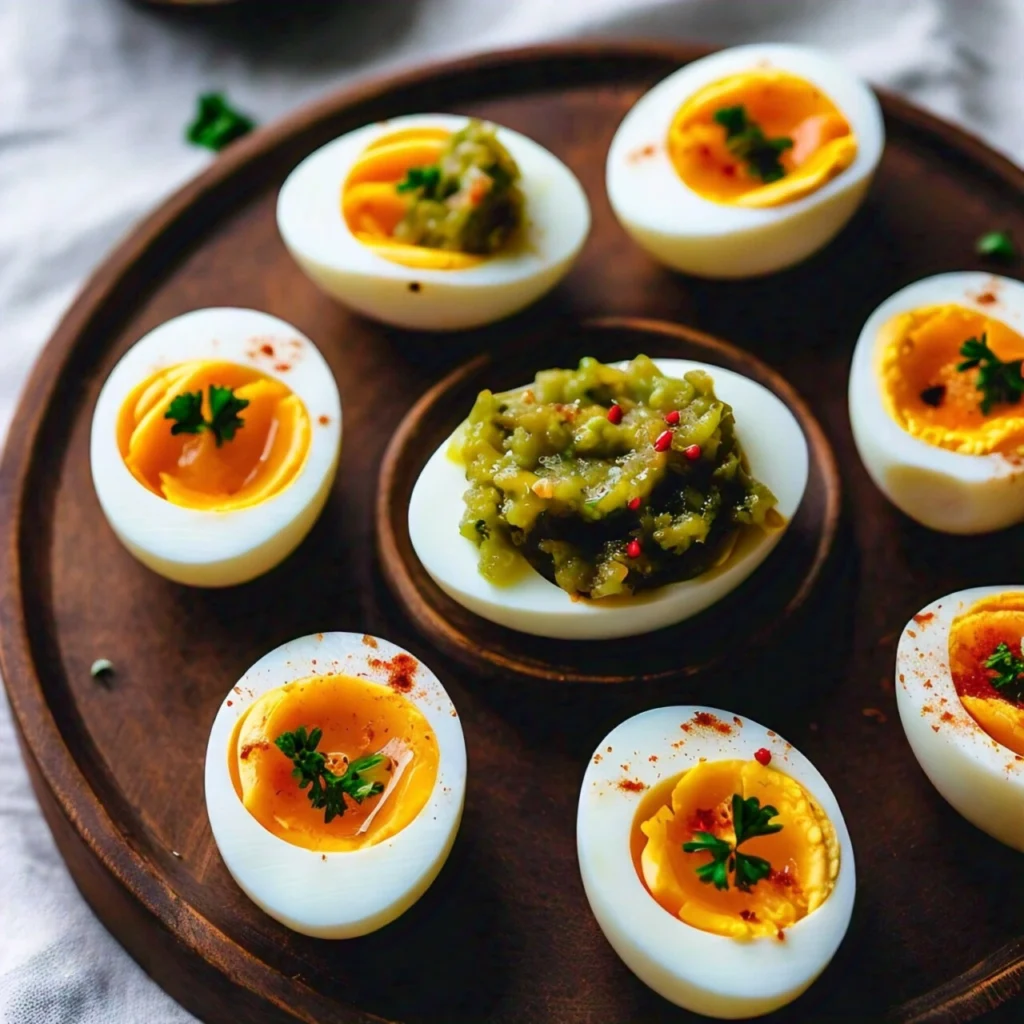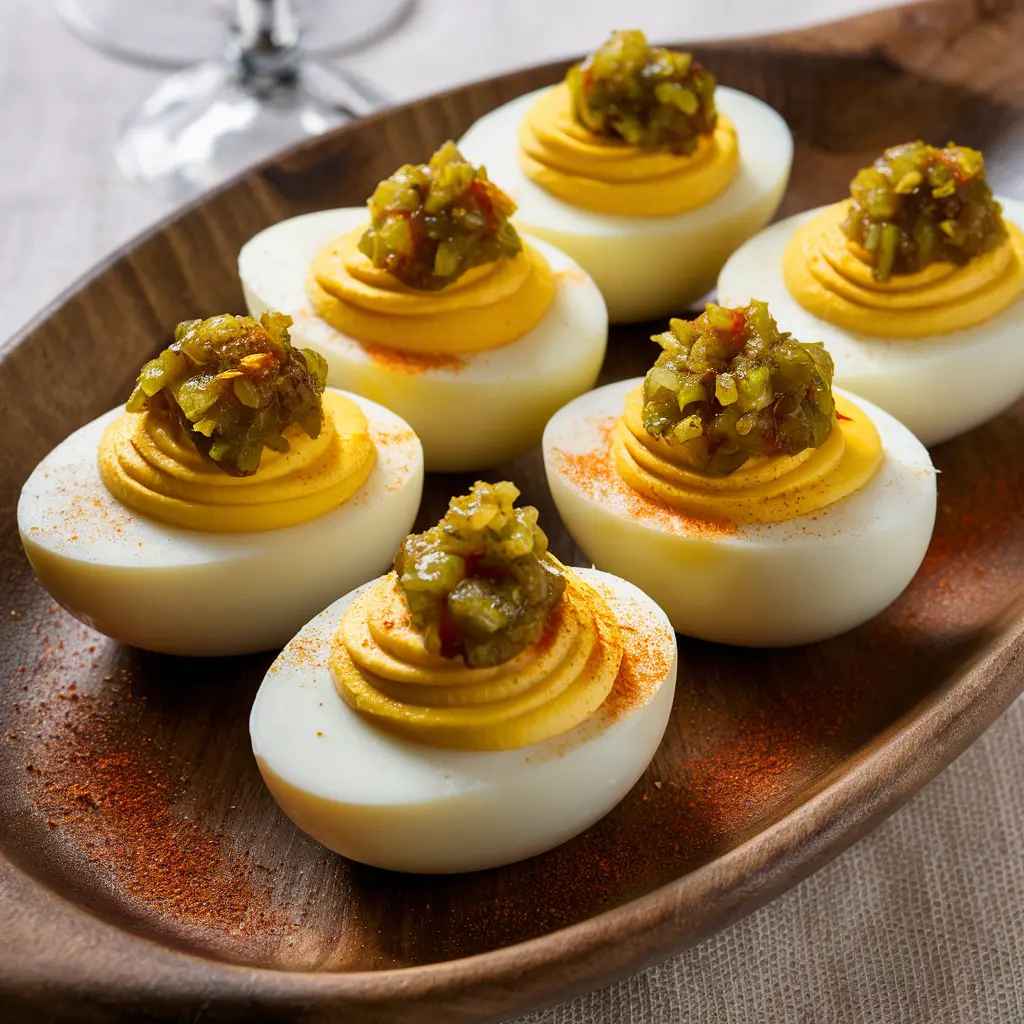Introduction to Deviled Eggs with Relish
Discover the delightful world of deviled eggs with relish! This popular appetizer marries the smooth texture of boiled eggs with the tangy kick of relish, creating a taste sensation that’s both familiar and exciting. Whether you’re a seasoned chef or a kitchen newbie, this guide will walk you through the steps to create the perfect deviled eggs with relish. So, get ready to wow your guests with this simple yet sophisticated dish that’s perfect for any occasion.
1: What Are Deviled Eggs with Relish?
Deviled eggs, also known as stuffed eggs, are a classic appetizer where hard-boiled eggs are halved, and their yolks are mixed with ingredients like mayonnaise and mustard. The addition of relish—a condiment made from diced vegetables, typically pickles—injects a vibrant flavor, enhancing the yolk’s creamy texture with a sweet or tangy burst, depending on the type of relish used.
Why Add Relish?
Adding relish to deviled eggs elevates the flavor profile significantly. The relish introduces a contrast that excites the palate, balancing the richness of the yolk mixture with acidity and sweetness. Whether you opt for sweet pickle relish or a tangy dill version, the inclusion of relish turns the ordinary deviled egg into a gourmet treat.
Popularity in Various Cuisines
Deviled eggs with relish are a staple in many Southern U.S. gatherings but have gained popularity across various cuisines due to their versatility and ease of preparation. These eggs are not just limited to picnics and family reunions; they’ve made their way into upscale menus and international dishes, showcasing their global appeal.
Overview of the Article Content
This article is your go-to guide for mastering deviled eggs with relish. From selecting the right ingredients to detailed step-by-step instructions, along with expert tips and variations, you’ll learn everything needed to perfect this dish. Plus, we’ll answer some common questions to help you avoid common pitfalls and make your eggs the highlight of any meal. So, let’s get cracking and start this egg-citing culinary journey!
2: Ingredients and Equipment Needed
To whip up deviled eggs with relish, you’ll need some simple, readily available ingredients and a few kitchen tools. Here’s everything you need to gather before you start cooking.
List of Ingredients
- Eggs: Large chicken eggs are the base of this dish. Fresh eggs can be harder to peel, so consider using eggs that are a few days old.
- Mayonnaise: This creamy component binds the yolk mixture together and adds richness.
- Mustard: Adds a sharp, tangy flavor that complements the sweetness of the relish.
- Relish: You can choose either sweet pickle relish for a milder taste or dill relish for a bit more zing.
- Salt and pepper: are crucial for enhancing and highlighting the flavors of the other components in the dish.
- Paprika: For a touch of color and a mild spice, sprinkled on top before serving.
Necessary Kitchen Equipment
- Medium Saucepan: For boiling the eggs.
- Slotted Spoon: Helps gently remove eggs from hot water.
- Mixing Bowl: For combining the yolk filling.
- Fork or Potato Masher: To mash the yolks.
- Piping Bag or Spoon: For neatly filling the egg whites with the yolk mixture.
- Plastic Wrap: If preparing in advance, to cover the filling and prevent drying.
Now that you’ve got your ingredients and equipment lined up, you’re all set to start making those delicious deviled eggs with relish. Each step is designed to ensure your eggs not only taste great but also look impeccable when you serve them. So, let’s move on to the next part where we’ll dive into the step-by-step recipe.
Step-by-Step Recipe

Creating deviled eggs with relish is a straightforward process that combines classic cooking techniques with simple assembly. Follow these steps to ensure your eggs are both delicious and visually appealing.
Preparing the Eggs
- Boil the Eggs: Place your eggs in a medium saucepan and cover them with cold water by 1 inch. Bring the water to a boil, then cover the pan and remove it from heat. Let it stand for 12 minutes. Afterward, transfer the eggs to a bowl of ice water to cool down quickly and stop the cooking process.
- Peel the Eggs: Once cool, gently crack the shells and peel them under running water. This helps remove the shells cleanly without damaging the egg whites.
Making the Filling
- Remove the Yolks: Halve the eggs lengthwise and carefully scoop out the yolks into a separate bowl. Ensure the whites remain intact for filling later.
- Combine Ingredients: Mash the yolks with a fork or potato masher until smooth. Add mayonnaise, mustard, and your choice of relish. Mix until well combined and creamy. Season with salt and pepper to taste.
Filling and Garnishing
- Fill the Egg Whites: Spoon the yolk mixture back into the egg whites or use a piping bag for a more professional finish. If you don’t have a piping bag, snip the corner off a plastic bag and fill it with the yolk mixture.
- Garnish: Sprinkle a little paprika over the filled eggs for color and a slight hint of spice. This not only adds flavor but also makes the eggs look more attractive.
By following these steps, you’ll create perfect deviled eggs with relish every time. They’re ideal for serving at gatherings, as they can be made ahead and refrigerated until it’s time to serve. For further insights and to enhance your skills, check out the tips and tricks in the next section of this guide. This will help you avoid common pitfalls and explore creative variations to impress your guests.
4: Tips and Tricks for Perfect Deviled Eggs
Mastering the art of making deviled eggs with relish involves a few insider tips and tricks. These suggestions will help you enhance your technique and add a creative twist to your dish.
How to Avoid Common Pitfalls
- Avoid Overcooking the Eggs: Overcooked eggs can have a greenish ring around the yolk and a rubbery texture. To prevent this, make sure to follow the boiling instructions carefully and cool the eggs immediately after cooking.
- Smooth Filling: For a creamy and smooth filling, ensure the yolks are mashed thoroughly before adding the other ingredients. Lumps in the yolk can make the filling uneven and difficult to pipe.
- Peeling Eggs: Fresh eggs are notoriously difficult to peel. Using eggs that are about a week old can make the peeling process smoother, as the pH level of the egg whites changes over time, allowing the shell to come off more easily.
Creative Variations
- Flavor Twists: Consider adding a small amount of horseradish or a dash of cayenne pepper to the yolk mixture for an extra kick. A teaspoon of vinegar or lemon juice can also enhance the tanginess, complementing the relish beautifully.
- Toppings: Beyond paprika, try garnishing your deviled eggs with relish with fresh herbs like dill or chives. For a crunchier texture, top them with crumbled bacon or finely chopped onions.
- Relish Options: While traditional recipes call for sweet or dill pickle relish, experimenting with other types like corn relish or even a homemade relish can introduce new flavors to your deviled eggs.
These tips and tricks are not only easy to incorporate but also make the preparation of deviled eggs with relish more enjoyable. With these strategies, you’re well on your way to becoming a deviled egg aficionado, ready to dazzle at your next party or gathering.
5: Cultural Significance and Regional Variations
Deviled eggs with relish are more than just a tasty appetizer; they carry a rich history and are a beloved part of culinary traditions in many regions, especially within the United States. In this section, we’ll delve into the cultural significance of deviled eggs and explore how different regions have put their unique spin on this classic dish.
The Roots of Deviled Eggs
The concept of stuffed eggs can be traced back to ancient Rome, where they were often served as a first course. The term “deviled,” in culinary contexts, dates back to the 18th century and refers to dishes that were made spicy or zesty with mustard, pepper, or other ingredients. Over the centuries, deviled eggs evolved into a popular side dish in Europe and later, America, particularly in the South.
Regional Variations in the U.S.
- Southern United States: Here, deviled eggs with relish are a staple at church potlucks, family reunions, and holiday dinners. Sweet pickle relish mixed into the yolk is the traditional choice, giving the eggs a distinctive sweet and tangy flavor.
- Midwestern and Eastern United States: Variations might include elements like vinegar and a sprinkling of celery salt, reflecting the region’s penchant for bold, savory flavors.
- Pacific Northwest: This area might see the inclusion of smoked salmon or crab in the filling, showcasing local seafood.
International Takes on Deviled Eggs
Globally, many cultures have adopted and adapted the basic deviled egg recipe to include local flavors:
- Spanish “Huevos Rellenos“: Often filled with a mixture of tuna, tomatoes, and mayonnaise, reflecting Spain’s rich tradition of seafood.
- Indian-style Deviled Eggs: These might include curry spices mixed into the filling, offering a warm, aromatic twist.
Exploring these regional and international variations not only enriches our understanding of deviled eggs with relish but also inspires us to experiment with our own recipes. This culinary journey across borders shows how a simple dish like deviled eggs can reflect a tapestry of cultural influences, making it a beloved treat enjoyed worldwide.
By understanding the diverse ways deviled eggs with relish are prepared and appreciated, we gain insight into the cultural dimensions of culinary practices and are inspired to bring these flavors into our own kitchens.
In the next part of our guide, we will address some frequently asked questions that might arise when making deviled eggs with relish. This will ensure you are fully prepared to handle any challenges and answer any queries your guests might have about this delightful dish.
6: Frequently Asked Questions
Let’s address some common queries about deviled eggs with relish to clear up any confusion and enhance your culinary knowledge.
Do Deviled Eggs Contain Relish?
While not all recipes for deviled eggs include relish, many variations, especially in the Southern U.S., incorporate sweet or dill pickle relish. The relish adds a vibrant tanginess or sweetness, enhancing the overall flavor of the eggs.
What is a Substitute for Sweet Pickle Relish in Deviled Eggs?
If you prefer not to use sweet pickle relish or don’t have it on hand, there are several substitutes that can add similar sweetness and texture:
- Chopped bread-and-butter pickles: These provide a similar sweet and tangy flavor profile.
- Chopped dill pickles with a pinch of sugar: This combination mimics the tanginess while adding a touch of sweetness.
- Chutney: A small amount can offer a unique sweet and spicy flavor.
Why Do People Put Vinegar in Deviled Eggs?
Vinegar is added to deviled eggs to enhance the flavor with a subtle tanginess that complements the richness of the yolks and mayonnaise. It also helps to balance the overall flavor profile, making the eggs more palatable and complex in taste.
What is Deviled Egg Filling Made Of?
The filling for deviled eggs typically consists of:
- Egg yolks: Hard-boiled and mashed to a smooth consistency.
- Mayonnaise: For creaminess.
- Mustard: Adds a sharp, tangy note.
- Seasonings: Such as salt, pepper, and often paprika.
- Optional add-ins: Like relish, vinegar, or herbs, depending on regional or personal preferences.
By understanding these elements of deviled eggs with relish, you can better appreciate the dish’s versatility and adapt it to suit your taste preferences or dietary needs. These insights help elevate your cooking and ensure that your deviled eggs are always a crowd-pleaser.
